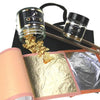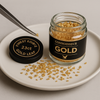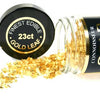Behind the Sparkle: How Edible Gold Is Made
- by sam@wrightsoflymm.co.uk User
When you bite into a dessert topped with glistening flecks of gold or hold a cocktail with shimmering specks floating inside, have you ever wondered how edible gold is made? From sheet to sparkle, here’s an insider’s look behind the luxury of gold leaf, gold dust, gold flakes, and their silver counterparts.
✨ What Is Edible Gold?
Edible gold refers to pure, food‑grade metal used for decoration in food and drink. Approved in the EU and UK under additive codes (E175 for gold, E174 for silver), it’s biologically inert and safe to eat. Common purities you’ll encounter are 23ct and 24ct gold—even though both are tasteless, they deliver unmatched visual elegance.
How Edible Gold Is Made
🛠️ Beating & Milling
The journey begins by melting 99.9% pure gold (23ct or 24ct), then rolling it thinner and thinner using rolling mills until it's just around 25 µm thick. This creates wide, delicate ribbons that are finally cut into small squares—or leaf sheets—ready to be further beaten using specialized layered materials like Mylar or traditional goldbeater’s skin.
Take a look at this video showing our MD Clive Stonehouse beating gold for Wrights of Lymm!
Cutting into Flakes & Dust
From leaf sheets, producers cut or shred the metal into gold flakes (typically 2–4 mm or larger) or gold dust (smaller particles under 1–2 mm). These forms allow easy application by sprinkling, brushing, or shaking on food and drinks.
Our Connoisseur Product Highlights
From the Edible Gold UK range, here are some standout items:
-
23 ct Gold Dust (500 mg jar): finely cut pieces (~1 mm), perfect for effortless sparkle over desserts or cocktails
-
2 grams 23 ct Gold Dust: larger quantity (~1–2 mm pieces), ideal for events or larger culinary displays
-
5 grams 23 ct Gold Dust: for catering and premium applications, packed as larger flakes for shimmer in larger batches
For silver enthusiasts:
-
Silver Pure Dust (100 mg, 500 mg, 1 g): edible silver particles ~1–2 mm in size, vegetarian‑safe, great for sprinkling ingredients or cocktail rims
-
Silver Flakes (100 mg to 1 g): 2–4 mm pieces from silver leaf, ideal for cocktails or dessert decoration, supplied in jars
🧪 Gold Leaf vs. Gold Flakes vs. Gold Dust (And Silver Versions)
| Form | Size | Ease of Use | Visual Effect |
|---|---|---|---|
| Gold Leaf (23ct/24ct) | Full sheets ~80×80 mm | Requires tweezers/brush | Bold, full‑surface coverage |
| Gold Flakes | ~2–4 mm (small) to ~5–8 mm (large) | Moderate (tweezers/brush) | Decorative contrast & texture |
| Gold Dust | <1–2 mm particles | Easy (shaker jar) | Gentle shimmer, great for drinks |
| Silver Leaf/Flakes/Dust | Similar to gold | Same | Cool-toned metallic accents |
Gold leaf is perfect for covering surfaces like cakes or steaks; gold flakes offer textured sparkle; gold dust provides subtle shimmer. Silver leaf/flakes/dust work similarly and are ideal for two‑tone plating or cocktail garnish.
Creative Applications: From Kitchen to Cocktail Bar
Edible gold and silver offer endless creative potential:
-
Desserts & Pastries: Apply 23ct gold leaf to fondant‑covered cakes or use gold flakes on macarons for show‑stopping finishes. For brighter impact, swirl gold dust over chocolates or truffles
-
Cocktails & Drinks: Drop a few 24ct gold flakes into champagne or gin fizz, or rim glass with silver dust for a cosmic shimmer effect — ideal for summer and festival drinks
-
Snacks & Treats: Sprinkle gold or silver flakes/dust over fruit parfaits, trail mix, marshmallows, or gilded honey‑drizzled nuts for luxe visual flair
Handling & Storage Tips
-
Work in a draft‑free environment—even breath can move leaf.
-
Use tweezers, soft brushes, or a tip, and never handle leaf with bare fingers (natural oils can cause tearing)
-
Store gold leaf, gold dust, gold flakes, silver leaf, silver dust, and silver flakes in their original packaging, in a cool, dry place to avoid damage or sticking
Why Purity Matters: 23ct vs 24ct
Both 23ct and 24ct gold are accepted for food use under E175 standards. 24ct is slightly purer—but 23ct is favoured for durability when creating leaf sheets and flakes. Silver variants comply with E174, and all products are vegetarian‑safe with no health concerns when consumed in conventional decorative quantities
Final Thoughts
The art of edible gold is as much about precision and tradition as it is about shine. Whether you choose gold leaf, gold flakes, or gold dust—and pair them with silver leaf, silver flakes, or silver dust—these products transform ordinary dishes into extraordinary experiences.
From the delicate hammer‑beating process that turns precious metals into whisper‑thin sheets, to the meticulous cutting that produces dust and flakes, the journey behind the sparkle is crafted with the same care you apply in the final plating. Embrace the luxury. Elevate with edible gold.






